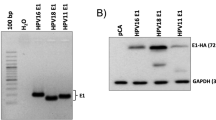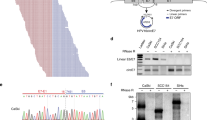Abstract
Specific types of human papillomaviruses (HPVs) cause cervical cancer, the second most common tumor in women worldwide. Both cellular transformation and the maintenance of the oncogenic phenotype of HPV-positive tumor cells are linked to the expression of the viral E6 and E7 oncogenes. To identify downstream cellular target genes for the viral oncogenes, we silenced endogenous E6 and E7 expression in HPV-positive HeLa cells by RNA interference (RNAi). Subsequently, we assessed changes of the cellular transcriptome by genome-wide microarray analysis. We identified 648 genes, which were either downregulated (360 genes) or upregulated (288 genes), upon inhibition of E6/E7 expression. A large fraction of these genes is involved in tumor-relevant processes, such as apoptosis control, cell cycle regulation, or spindle formation. Others may represent novel cellular targets for the HPV oncogenes, such as a large group of C-MYC-associated genes involved in RNA processing and splicing. Comparison with published microarray data revealed a substantial concordance between the genes repressed by RNAi-mediated E6/E7 silencing in HeLa cells and genes reported to be upregulated in HPV-positive cervical cancer biopsies.



Similar content being viewed by others
References
zur Hausen H (2002) Papillomaviruses and cancer: from basic studies to clinical application. Nat Rev Cancer 2:342–350
Boyer SN, Wazer DE, Band V (1996) E7 protein of human papilloma virus-16 induces degradation of retinoblastoma protein through the ubiquitin-proteasome pathway. Cancer Res 56:4620–4624
Munger K, Basile JR, Duensing S, Eichten A, Gonzalez SL, Grace M, Zacny VL (2001) Biological activities and molecular targets of the human papillomavirus E7 oncoprotein. Oncogene 20:7888–7898
Duensing S, Duensing A, Crum CP, Munger K (2001) Human papillomavirus type 16 E7 oncoprotein-induced abnormal centrosome synthesis is an early event in the evolving malignant phenotype. Cancer Res 61:2356–2360
Vogt M, Butz K, Dymalla S, Semzow J, Hoppe-Seyler F (2006) Inhibition of Bax activity is crucial for the antiapoptotic function of the human papillomavirus E6 oncoprotein. Oncogene 25:4009–4015
Wells SI, Aronow BJ, Wise TM, Williams SS, Couget JA, Howley PM (2003) Transcriptome signature of irreversible senescence in human papillomavirus-positive cervical cancer cells. Proc Natl Acad Sci U S A 100:7093–7098
Thierry F, Benotmane MA, Demeret C, Mori M, Teissier S, Desaintes C (2004) A genomic approach reveals a novel mitotic pathway in papillomavirus carcinogenesis. Cancer Res 64:895–903
Webster K, Parish J, Pandya M, Stern PL, Clarke AR, Gaston K (2000) The human papillomavirus (HPV) 16 E2 protein induces apoptosis in the absence of other HPV proteins and via a p53-dependent pathway. J Biol Chem 275:87–94
Demeret C, Garcia-Carranca A, Thierry F (2003) Transcription-independent triggering of the extrinsic pathway of apoptosis by human papillomavirus 18 E2 protein. Oncogene 22:168–175
Blachon S, Bellanger S, Demeret C, Thierry F (2005) Nucleo-cytoplasmic shuttling of high risk human Papillomavirus E2 proteins induces apoptosis. J Biol Chem 280:36088–36098
Garner-Hamrick PA, Fostel JM, Chien WM, Banerjee NS, Chow LT, Broker TR, Fisher C (2004) Global effects of human papillomavirus type 18 E6/E7 in an organotypic keratinocyte culture system. J Virol 78:9041–9050
Rosty C, Sheffer M, Tsafrir D, Stransky N, Tsafrir I, Peter M, de Cremoux P, de La Rochefordiere A, Salmon R, Dorval T, Thiery JP, Couturier J, Radvanyi F, Domany E, Sastre-Garau X (2005) Identification of a proliferation gene cluster associated with HPV E6/E7 expression level and viral DNA load in invasive cervical carcinoma. Oncogene 24:7094–7104
Santin AD, Zhan F, Bignotti E, Siegel ER, Cane S, Bellone S, Palmieri M, Anfossi S, Thomas M, Burnett A, Kay HH, Roman JJ, O’Brien TJ, Tian E, Cannon MJ, Shaughnessy J Jr, Pecorelli S (2005) Gene expression profiles of primary HPV16- and HPV18-infected early stage cervical cancers and normal cervical epithelium: identification of novel candidate molecular markers for cervical cancer diagnosis and therapy. Virology 331:269–291
Brummelkamp TR, Bernards R, Agami R (2002) A system for stable expression of short interfering RNAs in mammalian cells. Science 296:550–553
Cole ST, Danos O (1987) Nucleotide sequence and comparative analysis of the human papillomavirus type 18 genome. Phylogeny of papillomaviruses and repeated structure of the E6 and E7 gene products. J Mol Biol 193:599–608
Butz K, Ristriani T, Hengstermann A, Denk C, Scheffner M, Hoppe-Seyler F (2003) siRNA targeting of the viral E6 oncogene efficiently kills human papillomavirus-positive cancer cells. Oncogene 22:5938–5945
Zhou G, Roizman B (2000) Wild-type herpes simplex virus 1 blocks programmed cell death and release of cytochrome c but not the translocation of mitochondrial apoptosis-inducing factor to the nuclei of human embryonic lung fibroblasts. J Virol 74:9048–9053
Butz K, Geisen C, Ullmann A, Zentgraf H, Hoppe-Seyler F (1998) Uncoupling of p21WAF1/CIP1/SDI1 mRNA and protein expression upon genotoxic stress. Oncogene 17:781–787
Schneider J, Buness A, Huber W, Volz J, Kioschis P, Hafner M, Poustka A, Sultmann H (2004) Systematic analysis of T7 RNA polymerase based in vitro linear RNA amplification for use in microarray experiments. BMC Genomics 5:29
Buness A, Huber W, Steiner K, Sultmann H, Poustka A (2005) arrayMagic: two-colour cDNA microarray quality control and preprocessing. Bioinformatics 21:554–556
Wettenhall JM, Smyth GK (2004) limmaGUI: a graphical user interface for linear modeling of microarray data. Bioinformatics 20:3705–3706
Beissbarth T, Speed TP (2004) GOstat: find statistically overrepresented Gene Ontologies within a group of genes. Bioinformatics 20:1464–1465
Calvano SE, Xiao W, Richards DR, Felciano RM, Baker HV, Cho RJ, Chen RO, Brownstein BH, Cobb JP, Tschoeke SK, Miller-Graziano C, Moldawer LL, Mindrinos MN, Davis RW, Tompkins RG, Lowry SF; Inflamm and Host Response to Injury Large Scale Collab. Res. Program (2005) A network-based analysis of systemic inflammation in humans. Nature 437:1032–1037
Bussey KJ, Kane D, Sunshine M, Narasimhan S, Nishizuka S, Reinhold WC, Zeeberg B, Ajay W, Weinstein JN (2003) Matchminer: a tool for batch navigation among gene and gene product identities. Genome Biol 4:R27
Schneider-Gadicke A, Schwarz E (1986) Different human cervical carcinoma cell lines show similar transcription patterns of human papillomavirus type 18 early genes. EMBO J 5:2285–2292
Hall AH, Alexander KA (2003) RNA interference of human papillomavirus type 18 E6 and E7 induces senescence in HeLa cells. J Virol 77:6066–6069
Hwang ES, Riese DJ 2nd, Settleman J, Nilson LA, Honig J, Flynn S, DiMaio D (1993) Inhibition of cervical carcinoma cell line proliferation by the introduction of a bovine papillomavirus regulatory gene. J Virol 67:3720–3729
Cullen BR (2006) Enhancing and confirming the specificity of RNAi experiments. Nat Methods 3:677–681
Fedorov Y, King A, Anderson E, Karpilow J, Ilsley D, Marshall W, Khvorova A (2005) Different delivery methods-different expression profiles. Nat Methods 2:241
Kelley ML, Keiger KE, Lee CJ, Huibregtse JM (2005) The global transcriptional effects of the human papillomavirus E6 protein in cervical carcinoma cell lines are mediated by the E6AP ubiquitin ligase. J Virol 79:3737–3747
Durst M, Croce CM, Gissmann L, Schwarz E, Huebner K (1987) Papillomavirus sequences integrate near cellular oncogenes in some cervical carcinomas. Proc Natl Acad Sci USA 84:1070–1074
Peter M, Rosty C, Couturier J, Radvanyi F, Teshima H, Sastre-Garau X (2006) MYC activation associated with the integration of HPV DNA at the MYC locus in genital tumors. Oncogene 25:5985–5993
Wentzensen N, Ridder R, Klaes R, Vinokurova S, Schaefer U, Doeberitz MK (2002) Characterization of viral-cellular fusion transcripts in a large series of HPV16 and 18 positive anogenital lesions. Oncogene 21:419–426
Kinoshita T, Shirasawa H, Shino Y, Moriya H, Desbarats L, Eilers M, Simizu B (1997) Transactivation of prothymosin alpha and c-myc promoters by human papillomavirus type 16 E6 protein. Virology 232:53–61
Oh ST, Kyo S, Laimins LA (2001) Telomerase activation by human papillomavirus type 16 E6 protein: induction of human telomerase reverse transcriptase expression through Myc and GC-rich Sp1 binding sites. J Virol 75:5559–5566
Gewin L, Galloway DA (2001) E box-dependent activation of telomerase by human papillomavirus type 16 E6 does not require induction of c-myc. J Virol 75:7198–7201
DeFilippis RA, Goodwin EC, Wu L, DiMaio D (2003) Endogenous human papillomavirus E6 and E7 proteins differentially regulate proliferation, senescence, and apoptosis in HeLa cervical carcinoma cells. J Virol 77:1551–1563
Bracken AP, Pasini D, Capra M, Prosperini E, Colli E, Helin K (2003) EZH2 is downstream of the pRB-E2F pathway, essential for proliferation and amplified in cancer. EMBO J 22:5323–5335
Kleer CG, Cao Q, Varambally S, Shen R, Ota I, Tomlins SA, Ghosh D, Sewalt RG, Otte AP, Hayes DF, Sabel MS, Livant D, Weiss SJ, Rubin MA, Chinnaiyan AM (2003) EZH2 is a marker of aggressive breast cancer and promotes neoplastic transformation of breast epithelial cells. Proc Natl Acad Sci USA 100:11606–11611
Varambally S, Dhanasekaran SM, Zhou M, Barrette TR, Kumar-Sinha C, Sanda MG, Ghosh D, Pienta KJ, Sewalt RG, Otte AP, Rubin MA, Chinnaiyan AM (2002) The polycomb group protein EZH2 is involved in progression of prostate cancer. Nature 419:624–629
Acknowledgements
This work was supported by the Landesstiftung Baden-Württemberg (P-LS-RNS/18) and by a grant from the German National Genome Research Network NGFN-2 (01GR0418). We thank Sabrina Balaguer and Gabi Rottsahl for excellent technical assistance. Ruprecht Kuner and Markus Vogt contributed equally to the work.
Author information
Authors and Affiliations
Corresponding author
Electronic supplementary material
Below is the link to the electronic supplementary material.
Supplementary Table 1
Microarray analysis (LIMMA) revealed 648 genes which were affected by siRNA-mediated inhibition of E6/E7 expression in HeLa cells. All genes fulfill the cut-off criteria of an FDR < 5% and a linear fold change ±1.5. Some genes were marked “yes” for their presence in previously published studies [6, 7, 11–13, 30,]. (PDF 428 kb)
Supplementary Table 2
Functional annotation of potential E6/E7 target genes which were identified in the present and in previously published studies [6, 7, 11–13, 30,]. Analysis was performed using the GO software GOstat. GO results were filtered with respect to the category “biological process,” as detailed in the text. Every GO category includes GO identifier, GO name, presence of the genes in the analyzed signatures (Groupcount) in comparison to the total amount of genes annotated in this GO category (Totalcount), and the statistical significance as p value. (PDF 214 kb)
Rights and permissions
About this article
Cite this article
Kuner, R., Vogt, M., Sultmann, H. et al. Identification of cellular targets for the human papillomavirus E6 and E7 oncogenes by RNA interference and transcriptome analyses. J Mol Med 85, 1253–1262 (2007). https://doi.org/10.1007/s00109-007-0230-1
Received:
Accepted:
Published:
Issue Date:
DOI: https://doi.org/10.1007/s00109-007-0230-1




